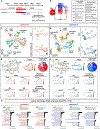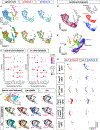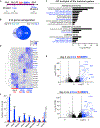In vitro atlas of dorsal spinal interneurons reveals Wnt signaling as a critical regulator of progenitor expansion
- PMID: 35858555
- PMCID: PMC9414195
- DOI: 10.1016/j.celrep.2022.111119
In vitro atlas of dorsal spinal interneurons reveals Wnt signaling as a critical regulator of progenitor expansion
Abstract
Restoring sensation after injury or disease requires a reproducible method for generating large quantities of bona fide somatosensory interneurons. Toward this goal, we assess the mechanisms by which dorsal spinal interneurons (dIs; dI1-dI6) can be derived from mouse embryonic stem cells (mESCs). Using two developmentally relevant growth factors, retinoic acid (RA) and bone morphogenetic protein (BMP) 4, we recapitulate the complete in vivo program of dI differentiation through a neuromesodermal intermediate. Transcriptional profiling reveals that mESC-derived dIs strikingly resemble endogenous dIs, with the correct molecular and functional signatures. We further demonstrate that RA specifies dI4-dI6 fates through a default multipotential state, while the addition of BMP4 induces dI1-dI3 fates and activates Wnt signaling to enhance progenitor proliferation. Constitutively activating Wnt signaling permits the dramatic expansion of neural progenitor cultures. These cultures retain the capacity to differentiate into diverse populations of dIs, thereby providing a method of increasing neuronal yield.
Keywords: BMP signaling; CP: Stem cell research; Wnt signaling; embryonic stem cells; expansion cultures; psychoactive drug signatures; retinoic acid; sensory interneurons; single-cell profiling; spinal cord.
Copyright © 2022 The Author(s). Published by Elsevier Inc. All rights reserved.
Conflict of interest statement
Declaration of interests The authors declare no competing interests.
Figures







References
Publication types
MeSH terms
Substances
Grants and funding
LinkOut - more resources
Full Text Sources
Other Literature Sources
Molecular Biology Databases
Miscellaneous

